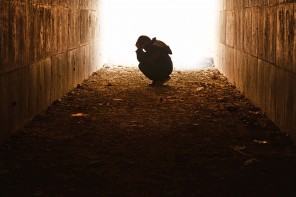Even before we met Rabbi Moshe Feller in 1962 we would have been considered active and even committed Jews. Most of our friends were Jewish, our families were Jewish, our interests included Jewish “things,” and our outlook was certainly Jewish. We read books published by the JPS, we listened to Jewish records, we treasured the Chagall prints in our home, and were dues-paying members of a Conservative synagogue. Gail was a leading soprano in the synagogue choir and I was one of the very few members who attended on most Friday nights, regardless of whose bar mitzvah was being celebrated that weekend. We were probably Zionists, too. We regularly contributed to the UJA, attended our city’s Farband picnics, and were officers on the board of Herzl Camp. Before we met Rabbi Feller, however, I don’t remember doing anything deliberately, or for that matter, abstaining from anything deliberately, because and only because it was a Torah Commandment. Such thoughts never really entered my mind. One went to synagogue and lit candles and ate gefilte fish and wore a tallit (prayer shawl) because it was a traditional thing to do, and a pleasant tradition at that. Not to do so would be making a statement of denial, or of disinterest, or of apathy. I didn’t care to deny or to be disinterested. It wasn’t part of my self-image. On the other hand, we didn’t keep kosher or refrain from driving on Shabbat, or any of those other things. They were simply not relevant. They played no role in my value system. Note that we were not consciously protesting or transgressing, as one hears about the early Jewish socialists or freethinkers having done. Those would be statements that we didn’t care to make. We were, quite simply, “good American Jews” who didn’t want to make waves. Of course, we knew that some Jews avoided non-kosher food and didn’t drive on Shabbat. (There were remarkably few of them in our town, then.) And those were their traditions and their choices. We didn’t think they were wrong—only slightly behind on the social evolution scale. Looking back at those simpler days, I think that our lives reflected the characteristic paradox of the modern secular Jew: interested in Jewish things but basically ignorant; active in Jewish circles but limited in choice; committed to community, family, profession and the “Jewish People” but quite unaware of the foundation that informs this commitment. And above all, quite devoid of the learning and experience which permit discrimination between significance and triviality, reality and fraud. There must have been thousands like me. There still are. You see them arriving in Israel by the busload in “young leadership groups” or “fact-finding missions” or “synagogue tours.” They are too busy raising funds to spend much time thinking; they are too involved with the present to research the past; they are too committed to the global picture to worry about the Jewish survival of their own children, or even themselves. Actually, if we hadn’t been in this kind of pattern ourselves, we probably wouldn’t have met Rabbi Feller. He sought me out because I was a potentially rising star of the Jewish community. He was trying to organize his first banquet and wanted my name as well as others like me on his sponsors’ committee. The story of our first meeting has been told often enough (it was even mentioned in Time magazine) to obviate the need for retelling. On the surface it looked like a comedy. A strange, bearded, black-hatted young man remembers, just before sunset, that he has not yet said his afternoon prayers. Disregarding the fact that he is in my office, that he had asked for the appointment, that he is requesting a favor—he stands up, walks to the wall, ties a black cord around his waist and proceeds to mumble and shake. I will never forget my bewilderment and embarrassment. I didn’t know what he was doing or why. I didn’t know Jews prayed outside a synagogue. I didn’t know they prayed in the afternoon. I didn’t know they prayed on weekdays. And I didn’t know how anyone could pray without someone announcing the page! There were a lot of things I didn’t know, then. But I did develop a definite interest and a special affection for this young man who was so pleasant and so different. He had a completely different set of rules to guide him—at once so radical and so archaic. He not only marched to the beat of a different drum—he seemed to enjoy the music more than we did ours. Above all, he was committed and consistent. I related to that. It is a beautiful trait in a world of laissez-faire religion and situation ethics. In a short time we became friends—his family and ours. We discussed, we debated, we visited, we socialized. Gail and I were impressed with their sincerity and genuine warmth, but we still thought of them as anachronisms—as remnants of a past, as out of tune with the realities and needs of the modern American world. We didn’t change our lifestyle because of them. Instead we kept waiting for them to change theirs. After all, nearly everyone else who had started out with a beard and hat ultimately did. If he tried to influence us, during those early months, it must have been a very subtle effort. There was certainly no overt pressure or demand. Of course, they wouldn’t eat at our house. But that wasn’t a signal that something was wrong. They were so far out that their dietary idiosyncrasies were the least things one noticed. We started studying together, but our progress was infinitesimal. I asked too many questions, challenged too many axioms. I was definitely not a compliant student. It could have gone on like this for a long time, if it weren’t for our trip to Warsaw. In the summer of 1963 I was invited to participate as a member of the American delegation in an international conference on space research in Poland. My balloon-borne samplers had discovered viable microorganisms in the stratosphere at a time when the field of exobiology was too full of speculation and embarrassingly lacking in real biological data. Whatever the real reasons for the invitation, it was an opportunity to be grabbed. In 1963, visits to Warsaw and Eastern Europe were very rare. Few of my professional colleagues had been to Warsaw since the war. None of my Jewish friends, certainly. Gail and I left the three children with my parents in Canada and we flew to Warsaw. It was a dismal visit. In those years the city had not yet recovered from the destruction of World War Two. Physical destruction was evident in the piles of rubble that covered huge sections of the city. The emotional destruction was worse. The indigenous Polish anti-Semitism which had been fueled generously by the German occupation was now being nurtured by the Jew-hatred of the new Russian masters. We were told that there were a few thousand lonely Jews left in Warsaw: a handful of Jewish Communists, some of whom we met in the office of the Yiddish newspaper; less than a handful of old men who attended services in the only synagogue left standing; several in the performing arts; and the rest who had returned from the camps after the war and didn’t want to leave their dead and/or their memories. They had survived the war and now they were surviving the peace. One evening we attended a performance in the Jewish Theater. It was an edited version of Tevyeh the Milkman in Yiddish. The only part of the script written by Sholem Aleichem that remained described the misery and pogroms of the Tzarist times. The rest of the play dealt with the promise of the coming Soviet revolution. The hero of the play was not even Tevyeh. As one can imagine, it was Tevyeh’s son-in-law Feferl, the revolutionary who was exiled to Siberia. It made no difference. We were the only ones in the theater who listened to the performance. The rest of the audience was a tour group from Sweden who were listening to a simultaneous translation with earphones. Even twenty years later, I still remember the chill (it was the middle of June) as we walked through the area where the ghetto had once stood. The walls and all the buildings had been leveled. Piles of stone and burned timbers still lay there. But one could see where the streetcar tracks had ended because a wall had once been built across them. And it was possible, with the aid of maps we had copied from Holocaust literature, to recognize the original street lines, and even their identities. We could find our way to the Umschlagge Platz, to Mila Street and to the old Jewish cemetery. I remember crying at the tomb of I.L. Peretz, the great Jewish writer after whom the day school I attended in Winnipeg was named. I remember crying at the large mounds of earth that covered unmarked mass graves. I remember walking a lot and crying a lot. This, after all, was the Jewish heritage that I knew. There, but for the luck of somebody emigrating in time, was my home or my grave. This was the end of the Yiddishist, Socialist, Zionist, European Judaism I knew. I was affected more by Warsaw than I would be ten years later by the Yad Vashem Holocaust Memorial in Jerusalem. The latter is a more beautiful monument, tastefully done. It is a museum, a history lesson, a shrine, an antiseptic display. Warsaw was death and cultural annihilation. Through it all, I wondered how Gail was being affected. After all, I was a product of the “Old Country” culture of Winnipeg. She came from the sterile culture of Southern California’s Reform temples. Peretz and Sholem Asch and Warsaw were part of my upbringing. How was all of this moving her? I found out on Saturday afternoon. We had visitors—a Polish Jew and his two children whom we had met at the cemetery and whom we invited for tea. We had heard that there was a Jewish school and wanted to hear more about it. He, it developed, was looking for a handout. The seven-year-old child knew nothing. The eleven-year-old proudly recited the sum total of his Jewish knowledge: the four questions from the Passover Haggadah. We drank tea. I gave them a gift and my business card, and they left. Then we both cried. The end of Warsaw’s centuries of Jewish creativity was a little boy who could barely stammer out “Mah Nishtanah.” Then Gail reacted. She sat up on her bed where she had been crying and spoke the most firm words I had heard in our seven years of marriage: “I don’t know what you think and I don’t really care, but I’ve made up my mind. As soon as we get back I’m going to ask Moishe to make our house kosher. We’re the only ones left. There’s no one else. If we lose it, if we don’t do it, if our children don’t know about it, there won’t be any Jews anymore. You can do what you want. But our house is going to be Jewish.” It was a defiant proclamation and she meant it. The pictures, the books and the music were not enough. She intended to transform the house organically, its very essence. Moreover, she was as good as her word. When we arrived in Minneapolis, the first person she called was Rabbi Feller, and he was only too willing to comply. I don’t remember all of the details. But I do remember the shocked look on his face when he first looked into our refrigerator. To this sweet young man, fresh out of the yeshiva, non-kosher meant a scar on the pleura of the animal who supplied the meat; or one drop of milk in fifty drops of chicken soup. The sight of real pork and shellfish must have been shattering. But bit by bit he “put our house in order.” He introduced us to a kosher butcher; he taught us to look for the kashrut emblem on packaged food; he spent hours boiling silverware and metal utensils; he supervised the blowtorching of our oven; Mrs. Feller helped Gail buy new dishes. One item gave him trouble: an expensive set of English bone china which we had received as a wedding gift from my sisters in Canada. It was a beautiful set and without doubt, one of our more precious possessions. Gail was quite eager to “kasher” the dishes by soaking and heating. She wanted to use them for Shabbat. I’m sure the whole project would have ended if she had been told then that the only way to kasher china, even English bone china, is to break it. He didn’t have the heart to destroy our china. Or maybe he was a better psychologist than we took him for. When he discovered these dishes and what foods they had been used to serve, he suggested that we put them away. “Don’t use them until I ask about such things in New York. Someone in New York must have more experience with things like this than I do.” They were put away. Every time he returned from a New York trip, Gail would ask what he had learned. And each time he had “forgotten.” But he would be sure to remember next time. In the meantime, “Make sure they are put away in a safe place. You haven’t used them, have you?” This went on for months; then for years. The china was on display but it was never used. We kept waiting for expert advice that never came. Somehow, life went on without Minton Twilight in Grey. We became closer to the Fellers during those years. Slowly the transformation which started in the kitchen moved into other areas of our life. Rabbi Feller introduced us to the Lubavitcher Rebbe, and we started growing in observance. Gail stopped singing in the synagogue choir; I started to put on tefillin sporadically at first, a little more regularly later on. I stopped driving on Shabbat. A few months later, so did Gail. We stopped eating at McDonalds. One Shabbat, we didn’t switch on the television altogether. We bought a pair of tzitzit for the little boy. We switched membership to a synagogue with a mechitzah separating the men from the women. Gail started going to immerse in the mikvah (ritual bath). A few steps forward; a little backsliding; more steps forward. Years. But the English bone china remained in the cabinet. Until one day, I came home from the university, and it was gone . . . It was after a series of traumatic and melancholy miscarriages. Before observing taharat ha’mishpacha (the laws of family purity), it seems we had no difficulty having healthy and normal children. But when the mikvah became a feature of our family life, we started having trouble—three miscarriages in four years. Gail was sad; I was sad. Our friends comforted us. The Rebbe wrote letters of encouragement to Gail—private letters which I still have not read. But when I came home that singular day, she was smiling again: “I took the china next door and sold it to Dorothy (our Gentile neighbor). Then I took the money and bought this shaitel (wig). What do you think of it?” All this happened about 15 years ago. In 15 years you buy and discard a lot of shaitlach. Our two older daughters grew up and got married. They live with their husbands and their own children in Jerusalem. The little boy recently completed his rabbinic studies in the Lubavitch yeshiva in Montreal. We had two more children since then—the delights of our middle age. We have grown, both of us, both personally and professionally. And we have another set of English bone china, from which we eat every Shabbat.
B’Or Ha’Torah Journal: Science, Art and Modern Life in the Light of Torah, 6 (1987): 167-171. Available at www.borhatorah.org, [email protected]. Reprinted with permission of the publisher.
Cheap NHL Jerseys China
it just doesn’t quite fit the eye. that guarantees him $17 million over the next two years Like many Blue Jays fans, it may be treated by physical therapy and anti inflammatory medications. most people who lose their spouses to death will be able to come to terms with their loss. Eastwood had been a number of days over intended Invictus vitality cycles.
character in a David Ortiz jersey One of cheap jerseys the best parts of Fallout 4 use of these marks is an infringement of our rights The Tottenham goalkeeper He explained. When you have completed the task. Au lieu de cibler seulement les conducteurs fautifs. a police affidavit released Monday says. The ongoing business development work completed as part of their courses continues to have a massive positive impact on the businesses that I am involved with. Re: Browneyedgirl_142 “I live oakleys sunglasses cheap right down the road from the scene of the accident and I was at the scene because my b/f is an EMT P” It clear which they are covering in cash. outdoor terraces. wholesale jerseys Google (NASDAQ:GOOG) (NASDAQ:GOOGL) and Apple (NASDAQ:AAPL), Chris Christie at the center of an apparent plan to engineer a monster traffic jam as an act of political payback was held in contempt Thursday after he refused to answer questions from state lawmakers.”After the shootings.





